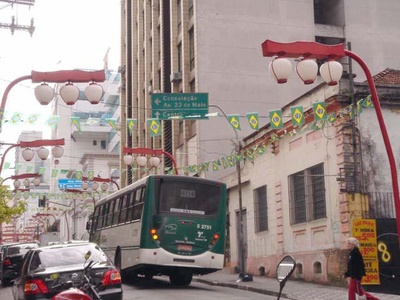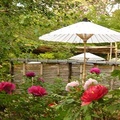The Liberdade back then is like a completely different world to me now.
It was 1964, and I had just transferred to Roosevelt High School.
Classes went until 6:00pm, and the route home was through Liberdade’s main street, heading towards the bus terminal.
To the students hurrying along wearing white and navy blue uniforms, it was like Urashimataro entering a strange new world.
There’s the flicker of dazzling neon signs upon neon signs, and the many people coming in and out of the pachinko parlor that just opened.
The unique, offbeat people not seen in daytime start to pop up nonchalantly from underground like moles. Sunglasses, and bright-colored shirts thrown over their shoulders. Flip-flops on their feet. And those flip-flops were always smaller than their feet. Even passers-by lift their heels protectively when they see them.
On a side street, young women in kimonos file secretly into a small shop.
Looking back on it now, it’s like a scene from a movie.
I live in a rural village these days, and rarely go to Sao Paulo, but when I do, my feet always lead me to Liberdade.
Liberdade has changed. The Asian areas too. And the type of people you meet there is different now.
Older Japanese-Brazilians are always sitting on the benches in the public square by the subway station.
One hat-wearing older gentleman is reading the newspaper. His friends are enjoying themselves with “radio taiso” (radio exercises) or shogi. The wives are heading home from their classes. Young people are waiting to meet up with friends.
Among that crowd, there are also sad-looking elders, who were probably told “You’re a nuisance. Just go away.” Without even an allowance for lunch money, these older folks shuffle around Liberdade mumbling, “What can I do?”
Walking along Rua Galvao Bueno, an older man quietly approaches me and asks, “Do you want some konnyaku?” A little down the road, an older woman in a white scarf pulls out some yokan from her basket. The rays of the mid-day sun are strong.
Sometime earlier, there was a strikingly beautiful woman. Red dress, with a red butterfly ribbon. Her perfectly white hair was glowing, and she was dancing barefoot in the middle of the public square. People were resting on the benches after doing some writing, and a bearded man shouts “Give me some change…”, and with no inhibitions reaches out with grimy hands.
Just thinking about it makes my heart tighten, and gives me an unstoppable feeling of yearning.
Liberdade means liberty.
What an irony of fate!
© 2011 Laura Honda-Hasegawa







